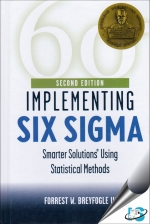Tab Article
This new and significantly revised edition of Implementing Six Sigma goes well beyond traditional Six Sigma methodologies, introducing an enhanced roadmap–S4/IEE (Smarter Six Sigma Solutions / Integrated Enterprise Excellence). This cutting-edge approach offers a solution to the common problem of sustaining Six Sigma activities and downplays the traditional policy stating that Six Sigma projects must have a defined defect. A variety of plans, checklists, metrics, and warnings of potential pitfalls provide thorough preparation for anyone implementing Six Sigma strategies.
With new coverage of Six Sigma infrastructure building, benchmarking, and real-world "lessons learned," this Second Edition is the best available tool for implementing these powerful, profit-building strategies.


